Panama’s climate refugees are still without a school
Three months after 300 families from the Guna Yala archipelago were relocated to the mainland, students still need to go to the island for classes. Teachers fear that drop-out rates could rise
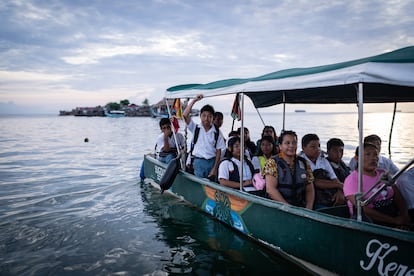
Students from eighth grade classrooms A and C wait in line to board small motorboats, clutching their English notes in one hand. The 20 minutes it takes them to get from the island of Cartí Sugdub to the mainland gives them time to study for their exam. Before she gets on the boat, 13-year-old Blanca slaps her forehead and takes off running. “I forgot my backpack at the house,” she yells as she runs down the alleyways of the over-populated Panamanian Caribbean island at risk of disappearing due to climate change. “Come quick or the boat is leaving without you,” warns her professor.
On the vessels, her classmates wait for her with their backpacks perched on their knees, their faces betraying nerves that can’t be entirely put down to their impending test. That morning at the beginning of June, they are practicing the trip to their new school on the mainland, where they were moved due to flood risk. They were scheduled to start using the new site quickly — none of them imagined that they wouldn’t set foot in it for three months. Its facilities remain closed, ironically, due to lack of water.
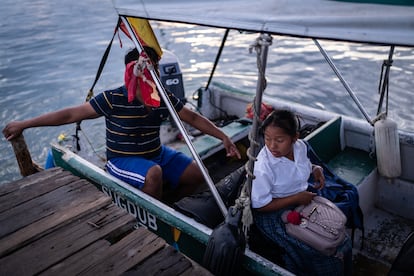
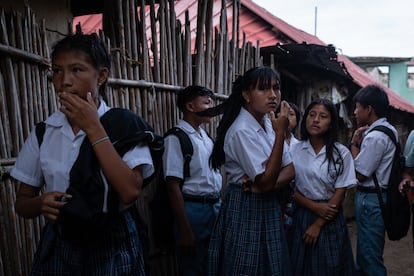

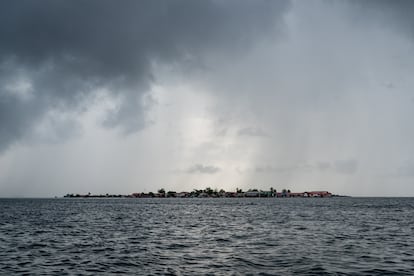
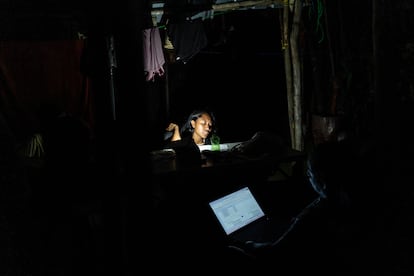
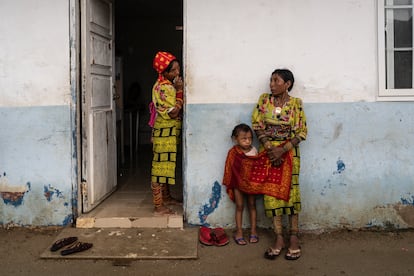
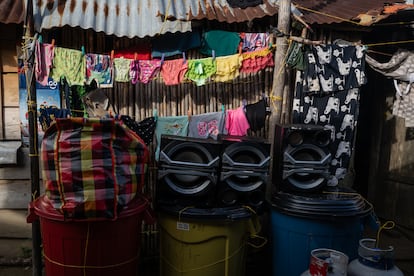
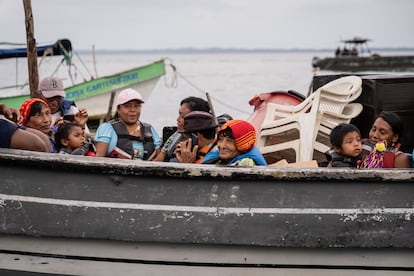
More than 10 years ago, Panama became the first Latin American country to relocate an entire community because of climate change. The education of its 600 children was an afterthought. The island’s classrooms have deteriorated and are susceptible to flooding, humidity and strong winds. “It’s quite common for the chairs to get wet and for there to be leaks,” says teacher Bernadeth Navarro, a special education instructor. “We are very eager to move to a new school. It’s an urgent matter, but a school that big can’t open if it doesn’t have water.”
The facility, whose construction was funded by the Inter-American Development Bank, was planned to include 120 bedrooms for students from other islands throughout the archipelago who are unable to commute back home every day. “I come and go to bring my daughter. Crossing is a challenge because of the tide. Often we’re wet when we arrive. We also have to wake up early … it’s not easy,” says Navarro.
Teachers worry that, given such difficulties, drop-out rates will increase. In 2022, more than 100,000 Panamanian children and teenagers left school before graduating. Those youngsters are concentrated in the capital and areas where the population is mainly Indigenous. Difficult commutes to class are a major factor in these numbers.

The students’ practice run coincides with a bittersweet day for the island’s inhabitants. That same June 3, the Cartí Sugdup community was relocated to a neighborhood built especially for them on the mainland, and they left behind the lives they once knew. Rising sea levels due to global warming are leaving many of the islands in the paradisiacal Guna Yala archipelago inhabitable. And so, Laurentino Cortizo’s government put together a project that had been under discussion in the past two presidential administrations: the relocation of the residents of at least 63 of Panama’s 365 islands. According to studies overseen by Ligia Castro de Doens, director of climate change at Panama’s Ministry of Environment, none of them will be inhabitable by 2050. The inhabitants of Blanca’s island were the first to be moved.
In addition to relocating the population, the government committed to building a multilingual and multiethnic school a little over a half-mile away from Isber Yala, the neighborhood to which a large part of Cartí's 300 families have moved. The majority, say some locals, come and go from the island, but sleep on the mainland.
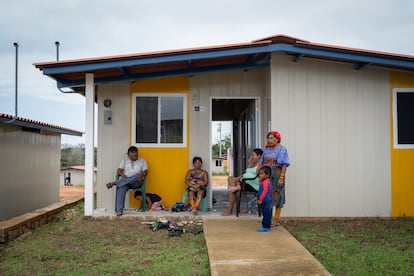
The change in presidential administrations last July, with the election of José Raúl Mulino, left the community waiting for its school. On her visit to the island, a dozen mothers implored the former minister of education, Maruja Villalobos, to “pass along the message” to her successor. “Don’t forget about our children,” asked a mother, gripping the former minister’s arm. “In this government, we want to take this seriously,” says Gregorio Green, head of the National Directorate of Intercultural Bilingual Education. “We hope to open at the end of August. Possibly by September they will be attending classes at a model school with a multiethnic curriculum,” he says. Some islanders like Atilio Martínez, a Guna historian and community leader, are less optimistic and believe there will be no classes until next year.
Having been in his position for less than a month, Green says via telephone that they are carrying out a pilot plan to supply material in Guna, Bri Bri and Buglé, among others languages, to the rural areas in which the country’s eight Indigenous communities live. In the city, no such pluralistic agenda is planned. “When we bring the texts and carry out the teacher trainings, I know that for many of them this is nothing new, because they’re already doing it. But now we want to support them. And do it well,” he says. The plan comes with a $65,000 budget, and its facilitators are determined that Law 88 will be more than words on a page.
The regulation, which was approved in 2010, recognizes the historic worth and heritage of cultural diversity and urges educational institutions to develop plans that take into account the mother tongue and traditional spirituality of Panama’s Indigenous peoples. “For us, it’s better not to lose our traditions,” explains the teacher. “We can’t say that to the children who come from other places, we have to love what our ancestors left us. We also have something that the capital doesn’t, and that is the way we love nature. We have to teach that as well in schools.”
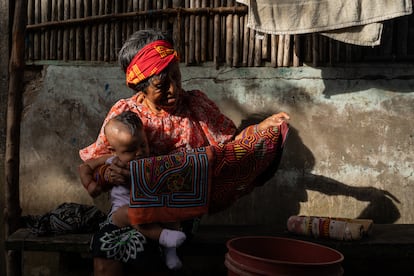
Sign up for our weekly newsletter to get more English-language news coverage from EL PAÍS USA Edition
Tu suscripción se está usando en otro dispositivo
¿Quieres añadir otro usuario a tu suscripción?
Si continúas leyendo en este dispositivo, no se podrá leer en el otro.
FlechaTu suscripción se está usando en otro dispositivo y solo puedes acceder a EL PAÍS desde un dispositivo a la vez.
Si quieres compartir tu cuenta, cambia tu suscripción a la modalidad Premium, así podrás añadir otro usuario. Cada uno accederá con su propia cuenta de email, lo que os permitirá personalizar vuestra experiencia en EL PAÍS.
¿Tienes una suscripción de empresa? Accede aquí para contratar más cuentas.
En el caso de no saber quién está usando tu cuenta, te recomendamos cambiar tu contraseña aquí.
Si decides continuar compartiendo tu cuenta, este mensaje se mostrará en tu dispositivo y en el de la otra persona que está usando tu cuenta de forma indefinida, afectando a tu experiencia de lectura. Puedes consultar aquí los términos y condiciones de la suscripción digital.
More information
Archived In
Últimas noticias
From Andorra to Gibraltar, a black market for Ozempic exploits its success: ‘They’re the most sought-after products in the world’
Magnets in their heads: How some animals guide themselves using the Earth’s magnetic field
From Hungary’s Orbán to Chile’s Kast: How Trump helps turbo charge the far right
The brief rise and retreat of Generation Z in Mexico
Most viewed
- Why we lost the habit of sleeping in two segments and how that changed our sense of time
- Trump’s obsession with putting his name on everything is unprecedented in the United States
- Charles Dubouloz, mountaineering star, retires at 36 with a farewell tour inspired by Walter Bonatti
- Venezuela faces its most tense Christmas yet
- The Florida Keys tourist paradise is besieged by immigration agents: ‘We’ve never seen anything like this’











































